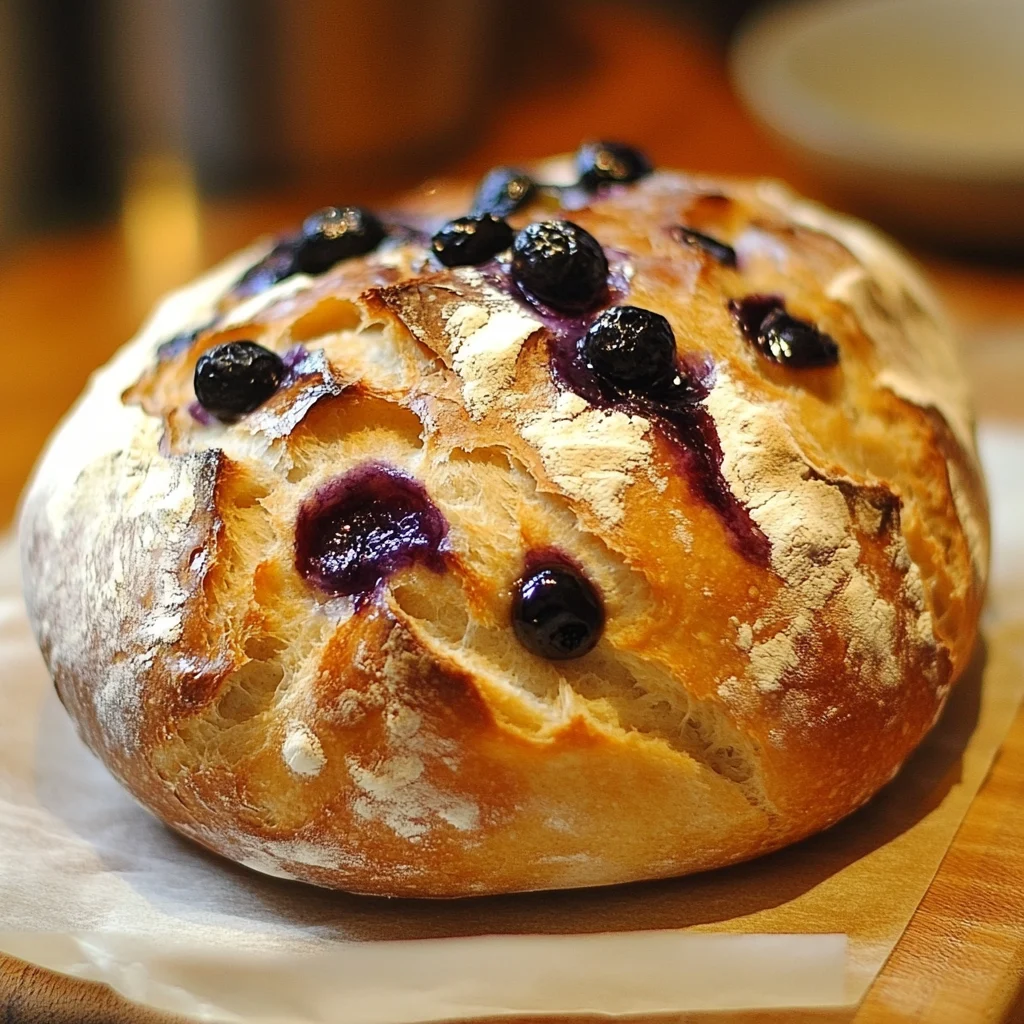Fruit Cream Sourdough Sensation: A Blueberry-Infused Delight

Description of this recipe: This Fruit Cream Sourdough is a celebration of flavors and textures, marrying the tangy depth of sourdough with the sweet bursts of blueberries and the creamy richness of a lemon-kissed cream cheese filling. Finished with a luscious honey-lemon glaze, this loaf is a showstopper that’s perfect for breakfast, brunch, or a delightful afternoon treat.
Why you will love this recipe: Beyond its stunning appearance, this sourdough loaf offers a complex and satisfying flavor profile. The natural fermentation process of sourdough imparts a unique tang, while the blueberries contribute a juicy sweetness that complements the creamy, citrusy filling. The honey-lemon glaze adds a final touch of brightness, making each bite an explosion of deliciousness. Making sourdough is rewarding and the results of this Fruit Cream Sourdough are something you will be proud to share.
Introduction
Sourdough baking can seem daunting, but trust me, the effort is worth it, especially when you’re rewarded with a loaf as exquisite as this Fruit Cream Sourdough. This recipe builds upon the fundamentals of sourdough, adding a layer of creativity and flavor that will impress even the most discerning palates. We’ll be guiding you through each step, from nurturing your starter to achieving that perfect golden crust. Don’t be discouraged by the longer fermentation times; they are key to developing the signature sourdough flavor and texture. This loaf is a testament to the magic that happens when time, patience, and quality ingredients come together. Whether you are an experienced baker or a beginner, this recipe is designed for everyone to follow!
Ingredients:
- 500g bread flour (high-protein, unbleached preferred)
- 350ml water, room temperature
- 100g active sourdough starter (fed and bubbly)
- 10g salt (sea salt or kosher salt)
- 1 cup fresh blueberries
- 1/3 cup cream cheese, softened
- Zest of 1 lemon
- 2 tablespoons granulated sugar
- 2 tablespoons honey
- 1 tablespoon fresh lemon juice

Preparation:
Step 1: Autolyse (Flour and Water)
In a large mixing bowl, combine the bread flour and room temperature water. Mix with your hand or a dough whisk until no dry flour remains. Cover the bowl and let it rest for 30 minutes. This process, called autolysing, allows the flour to fully hydrate, resulting in a more extensible and elastic dough. It contributes to a softer crumb and a better overall texture. Think of it as giving the flour a head start!
Step 2: Incorporate Starter and Salt
After the autolyse, add the active sourdough starter to the dough. Mix well until the starter is evenly distributed. This may take a few minutes. Next, add the salt. Salt is crucial for controlling fermentation and developing the gluten structure. Mix again until the salt is fully incorporated.
Step 3: Bulk Fermentation (Stretch and Folds)
Cover the bowl and let the dough rest for 4-6 hours at room temperature. During this bulk fermentation period, you’ll perform a series of stretch and folds every 30 minutes. To perform a stretch and fold, gently grab a portion of the dough, lift it up, and fold it over onto itself. Rotate the bowl and repeat this process until you’ve stretched and folded the entire dough. This strengthens the gluten network, creating a more structured and airy loaf. The frequency of stretch and folds can be adjusted depending on the temperature and the strength of your starter.
Step 4: Prepare the Cream Cheese Filling and Incorporate Blueberries
While the dough is bulk fermenting, prepare the cream cheese filling. In a separate bowl, combine the softened cream cheese, lemon zest, and granulated sugar. Mix until smooth and creamy. Set aside. During the final stretch and fold of the bulk fermentation, gently incorporate the fresh blueberries into the dough. Be careful not to overmix, as this can crush the blueberries and stain the dough.
Step 5: Shaping and Filling
Gently transfer the dough to a lightly floured surface. Use a rolling pin to roll it into a large rectangle. Spread the cream cheese mixture evenly over the rectangle, leaving a small border around the edges. Carefully roll the dough up tightly, like a jelly roll, starting from one long side. Pinch the seam to seal it tightly. Gently transfer the rolled dough, seam-side up, to a well-floured banneton basket or a bowl lined with a floured kitchen towel.
Step 6: Cold Proofing
Cover the banneton basket or bowl with plastic wrap or a damp kitchen towel and refrigerate for 8-12 hours. This cold proofing process slows down the fermentation, allowing the flavors to develop further.
Step 7: Baking
Preheat your oven to 250°C (482°F) with a Dutch oven inside for at least 30 minutes. Carefully remove the hot Dutch oven from the oven. Gently invert the dough from the banneton basket into the Dutch oven. Score the top of the loaf with a sharp knife or lame. This allows the bread to expand during baking and prevents it from bursting.
Step 8: Bake with Lid
Cover the Dutch oven with the lid and bake for 20 minutes. The lid traps steam, creating a moist environment that encourages oven spring and a crisp crust.
Step 9: Bake without Lid
Remove the lid and continue baking for 20-25 minutes, or until the loaf is deeply golden brown and the internal temperature reaches 95-98°C (203-208°F).
Step 10: Honey-Lemon Glaze
While the loaf is baking, prepare the honey-lemon glaze. In a small bowl, whisk together the honey and fresh lemon juice.
Step 11: Glaze and Cool
Once the loaf is baked, remove it from the Dutch oven and place it on a wire rack to cool. While the loaf is still warm, brush it generously with the honey-lemon glaze. Let the loaf cool completely before slicing and serving.
COOKING Rating:
Difficulty: Difficult (Requires sourdough starter maintenance and familiarity with sourdough baking techniques.)
Serving Suggestions:
- Serve slices of this Fruit Cream Sourdough warm or at room temperature.
- Pair with a cup of coffee or tea.
- Enjoy as part of a brunch spread.
- Toast slices and top with butter or cream cheese.
- Serve alongside fresh fruit or berries.
Tips:
- Ensure your sourdough starter is active and bubbly before starting the recipe.
- Use high-quality bread flour for the best results.
- Don’t overmix the dough, especially after adding the blueberries.
- Cold proofing is crucial for developing flavor and texture.
- Baking in a Dutch oven creates a steamy environment, resulting in a crisp crust.
- Adjust the baking time according to your oven.
- Let the loaf cool completely before slicing to prevent a gummy texture.
Prep Time: 600 Minutes (including starter feeding and fermentation)
Cook Time: 45 Minutes
Total Time: 645 Minutes
Nutritional Information (Per Serving – approximate):
Calories: 350-400 kcal (estimation will vary based on ingredients.) Protein: 8-10g Sodium: 200-250mg
Conclusion
Congratulations! You’ve successfully created a beautiful and delicious Fruit Cream Sourdough. This recipe is a testament to the power of sourdough and the joy of baking. Enjoy the fruits of your labor and share this delightful loaf with family and friends. Remember, sourdough baking is a journey, and each loaf will be unique. Embrace the imperfections and learn from each experience. Keep practicing, and you’ll become a sourdough master in no time!
Frequently Asked Questions:
Q1: Can I use frozen blueberries instead of fresh blueberries?
A: While fresh blueberries are highly recommended for their superior texture and flavor, you can use frozen blueberries in a pinch. However, be sure to thaw them completely and gently pat them dry before adding them to the dough to prevent them from bleeding and making the dough soggy.
Q2: My sourdough starter is not very active. Can I still use it?
A: For optimal results, it’s crucial to use an active and bubbly sourdough starter. If your starter is sluggish, it may take longer for the dough to rise, and the loaf may not have the desired flavor and texture. Try feeding your starter a few times over a couple of days to boost its activity before using it in this recipe.
Q3: I don’t have a Dutch oven. Can I bake this loaf on a baking sheet?
A: While a Dutch oven is ideal for creating a steamy environment that promotes a crisp crust, you can bake this loaf on a baking sheet. To create steam, place a pan of hot water on the bottom rack of your oven while the loaf bakes. This will help to create a similar effect. However, the crust may not be as crisp as it would be if baked in a Dutch oven.
Q4: Can I substitute the cream cheese filling with something else?
A: Absolutely! You can customize the filling to your liking. Some delicious alternatives include ricotta cheese, mascarpone cheese, or even a fruit jam. Just be sure to adjust the sweetness accordingly.
Q5: My loaf came out dense and gummy. What could have gone wrong?
A: There are several factors that could contribute to a dense and gummy loaf. It could be due to an inactive starter, under-fermentation, over-mixing, or not allowing the loaf to cool completely before slicing. Review each step of the recipe and pay close attention to the details to identify the potential cause. With practice, you’ll learn to troubleshoot and perfect your sourdough baking technique.

Fruit Cream Sourdough Sensation: A Blueberry-Infused Delight
Ingredients
- 500 g bread flour high-protein, unbleached preferred
- 350 ml water room temperature
- 100 g active sourdough starter fed and bubbly
- 10 g salt sea salt or kosher salt
- 1 cup fresh blueberries
- 1/3 cup cream cheese softened
- Zest of 1 lemon
- 2 tablespoons granulated sugar
- 2 tablespoons honey
- 1 tablespoon fresh lemon juice
Instructions
- Step 1: Autolyse (Flour and Water)
- In a large mixing bowl, combine the bread flour and room temperature water. Mix with your hand or a dough whisk until no dry flour remains. Cover the bowl and let it rest for 30 minutes. This process, called autolysing, allows the flour to fully hydrate, resulting in a more extensible and elastic dough. It contributes to a softer crumb and a better overall texture. Think of it as giving the flour a head start!
- Step 2: Incorporate Starter and Salt
- After the autolyse, add the active sourdough starter to the dough. Mix well until the starter is evenly distributed. This may take a few minutes. Next, add the salt. Salt is crucial for controlling fermentation and developing the gluten structure. Mix again until the salt is fully incorporated.
- Step 3: Bulk Fermentation (Stretch and Folds)
- Cover the bowl and let the dough rest for 4-6 hours at room temperature. During this bulk fermentation period, you’ll perform a series of stretch and folds every 30 minutes. To perform a stretch and fold, gently grab a portion of the dough, lift it up, and fold it over onto itself. Rotate the bowl and repeat this process until you’ve stretched and folded the entire dough. This strengthens the gluten network, creating a more structured and airy loaf. The frequency of stretch and folds can be adjusted depending on the temperature and the strength of your starter.
- Step 4: Prepare the Cream Cheese Filling and Incorporate Blueberries
- While the dough is bulk fermenting, prepare the cream cheese filling. In a separate bowl, combine the softened cream cheese, lemon zest, and granulated sugar. Mix until smooth and creamy. Set aside. During the final stretch and fold of the bulk fermentation, gently incorporate the fresh blueberries into the dough. Be careful not to overmix, as this can crush the blueberries and stain the dough.
- Step 5: Shaping and Filling
- Gently transfer the dough to a lightly floured surface. Use a rolling pin to roll it into a large rectangle. Spread the cream cheese mixture evenly over the rectangle, leaving a small border around the edges. Carefully roll the dough up tightly, like a jelly roll, starting from one long side. Pinch the seam to seal it tightly. Gently transfer the rolled dough, seam-side up, to a well-floured banneton basket or a bowl lined with a floured kitchen towel.
- Step 6: Cold Proofing
- Cover the banneton basket or bowl with plastic wrap or a damp kitchen towel and refrigerate for 8-12 hours. This cold proofing process slows down the fermentation, allowing the flavors to develop further.
- Step 7: Baking
- Preheat your oven to 250°C (482°F) with a Dutch oven inside for at least 30 minutes. Carefully remove the hot Dutch oven from the oven. Gently invert the dough from the banneton basket into the Dutch oven. Score the top of the loaf with a sharp knife or lame. This allows the bread to expand during baking and prevents it from bursting.
- Step 8: Bake with Lid
- Cover the Dutch oven with the lid and bake for 20 minutes. The lid traps steam, creating a moist environment that encourages oven spring and a crisp crust.
- Step 9: Bake without Lid
- Remove the lid and continue baking for 20-25 minutes, or until the loaf is deeply golden brown and the internal temperature reaches 95-98°C (203-208°F).
- Step 10: Honey-Lemon Glaze
- While the loaf is baking, prepare the honey-lemon glaze. In a small bowl, whisk together the honey and fresh lemon juice.
- Step 11: Glaze and Cool
- Once the loaf is baked, remove it from the Dutch oven and place it on a wire rack to cool. While the loaf is still warm, brush it generously with the honey-lemon glaze. Let the loaf cool completely before slicing and serving.






